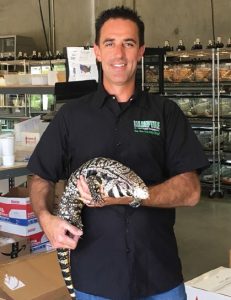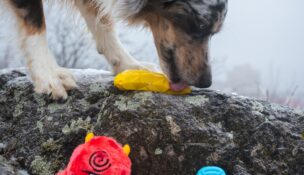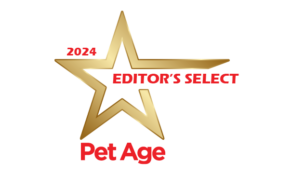Reptilian Fascination: A Q&A with the Owner of LLLReptile and Supply Company, Inc.,
Colleen Murphy//June 27, 2017//
Reptilian Fascination: A Q&A with the Owner of LLLReptile and Supply Company, Inc.,
Colleen Murphy //June 27, 2017//
According to his company’s website, Loren Leigh was “never a self-proclaimed reptile person” when he was growing up. Years later, as owner of LLLReptile and Supply Company, Inc., and its wholesale division, Vista Pet Supply, it is clear that things have changed.
“I got into reptiles later in my life, in my late teens,” Leigh recalled. “Most people have stories of having reptiles all their life and, yes, I had a few, but it was not a passion until around 19. I got my first pair of flap jack chameleons, and the rest was history. I was hooked, but not only on the animals themselves but their captive husbandry, techniques to care, breeding, natural history and more.”
Leigh soon landed a job at a leading reptile facility, learning the industry as quickly as he could. He worked in the field for three years before opening LLLReptile and Supply Company with its first store in Oceanside, California, over 20 years ago. Today, the company has five locations, including its newest store in Las Vegas.
With LLLReptile and Supply Company, Inc., and Vista Pet Supply, Leigh oversees his retail stores, three fully integrated distribution warehouses and a reptile breeding facility, according to the SuperZoo website, but he also takes time to be “an advocate of responsible husbandry of reptiles, amphibians and other exotic creatures and supports conservation efforts for all animals.”
He also finds time to attend SuperZoo; this will be Leigh’s fifth year speaking at the event. He will be giving two talks this year: “Demystifying Chameleons” on Tuesday at 3 p.m. to go over the popularity of these fascinating reptiles and a “Reptile Handling Workshop” on Wednesday at 10 a.m. that will give attendees the opportunity to interact with many reptile species and learn how to properly handle and understand their unique features.
Pet Age asked Leigh about how he chooses the topics of discussion for his presentations, what manufacturers on the trade show floor can do to attract retailers to their booths and make the sale, what reptile trends are emerging and more.
Q: What is it about reptiles that fascinates you?
A: What I found so fascinating about reptiles—and still do to this day—is not only reptiles’ uniqueness but their uniqueness to their environment. I found the little pockets they are found throughout the world interesting, and as the hobby was expanding, so was the interest in all animal types. When I started, it was big snakes and lizards and has now expanded into frogs, toads, chameleons, lizards, turtles, tortoises, spiders, roaches, [and] assorted
arachnids to name just a few of the segments gaining popularity.
Q: How do you decide what your talk will be about each year?
A: I base what I present on current trends in the reptile industry and topics I feel the retailer could benefit as they consider carrying and expanding their reptile
department. As a retailer specializing in the reptile category, I watch trends and new development in animals, products and food very closely. I also like to incorporate the animals themselves directly into the discussion to give people the opportunity to see, hold and really get up close with these amazing reptiles.
Q: As a retailer, what catches your eye when walking the trade show floor?
A: When I walk the sales floor, I am looking for innovation in the reptile category. The advancement of our hobby is so directly tied to the advancement of products and foods. As manufacturers develop new lighting, new bedding and new food alternatives, I see expansion into reptiles currently not easily kept due to this innovation. And these are not always products directly manufactured with reptiles in mind. It could be a product made for small animals that has cross over into the reptile category as well. What makes me stop in my tracks recently is caging and also lighting. Th e reptile caging has adva nced as we move from using old fish tanks converted to reptile enclosures to enclosures designed specifically for reptiles and also lighting that gets closer to the natural spectrums of light produced by the sun.
nced as we move from using old fish tanks converted to reptile enclosures to enclosures designed specifically for reptiles and also lighting that gets closer to the natural spectrums of light produced by the sun.
Q: What is something you think a manufacturer can do to secure more deals with retailers while at SuperZoo?
A: Have a very good knowledge of exactly what their product can do for the reptiles it is designed to be used for. Many manufacturers develop incredible products that get lost when information on how it can be properly used or the animals it will specifically benefit are not properly identified. Learning about the animals these products are designed for is essential in selling to the reptile specialty stores.
Q: A retailer is considering stocking reptile items. What’s one of the most important things he or she should know before making that leap?
A: One of the fi rst suggestions I give any store looking to stock reptile products is to make sure they have a good understanding of their use and importance to stock necessary items. Th e reptile hobby is expansive with basically anything that is not a mammal, feathered or with fins falling into this segment. The care of a lizard is much different than the care of a tortoise, and not even in the same world as frogs or spiders, for example. It can be overwhelming when you see the hundreds of light bulb options, hundreds of bedding options. Th e key is to identify what animals you want to sell or sell and carry the products needed to care for these species properly. The segment is full of specialty manufacturers and distributors, such as us at Vista Pet Supply, eager to inform shop openers of the products that are best to stock and explain their use.
Q: What reptile trends do you predict will emerge in the near future?
A: The reptile category is just growing more year after year. Today we are over 7 percent of pet ownership, and that number is only going to expand. One of the interesting trends right now is arachnids and invertebrates. The fascinating array of tarantulas, spiders and scorpions available today in the hobby is staggering. Our company alone has 60+ species available at any given time. The captive production of spiders throughout the world has tripled in just the last five years.
Another group of animals that is gaining more and more popularity is chameleons. As technology in care equipment has advanced, the advancement of this segment of the hobby has followed suit. This is an animal that at one time was considered extremely difficult to care for, but modern husbandry techniques has this group of animals more available than ever to keep.
One last trend that has only grown and will continue to is the building of vivariums and pallidariums. The keeping of frogs (especially poison arrow frogs) has expanded the need and use of natural products like live plants, live mosses, exotic woods, natural beddings and more. There is a trend to natural products to create a sliver of the rainforest or even deserts right in your home. People are moving away from the larger species that dominated the reptile hobby at one time and into small environments, making the environment the focal point along with the animal.
Q: What has been the most exciting change about SuperZoo over the years you’ve attended?
A: It has been amazing to see the event grow over the years. I have always been a huge fan of WPA [World Pet Association] incorporating animals into the show in Critter Alley and School of Wellness discussions. It is important that we remember that without livestock there would be no need for the products and foods being produced.



















